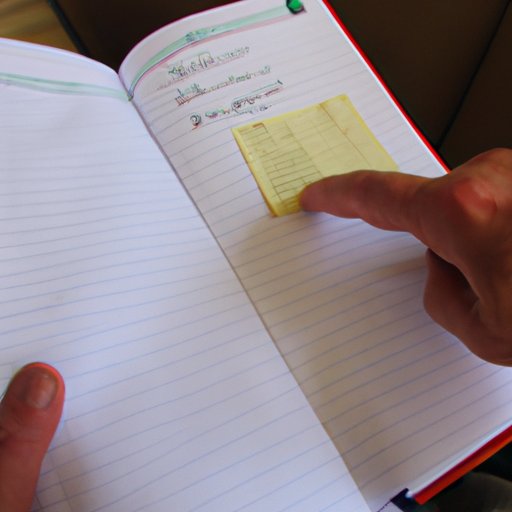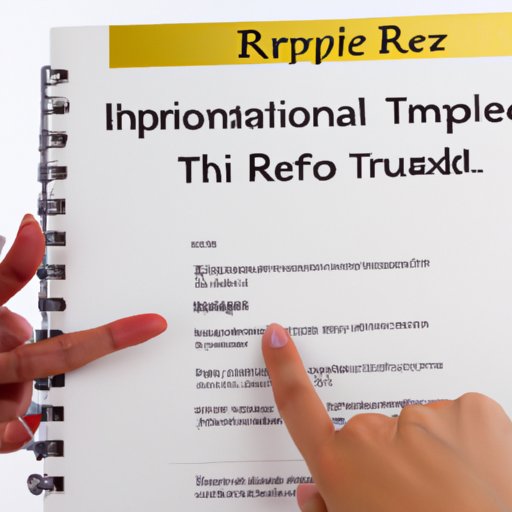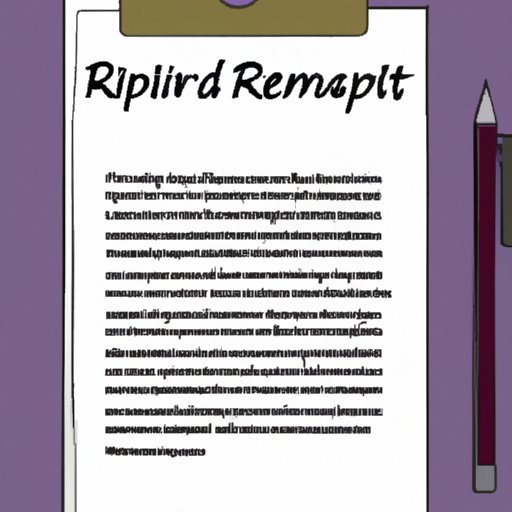Introduction
A trip report is a structured document that details the events and observations made during a business or leisure trip. It is important to document the purpose of the trip and the findings in order to assess the success of the trip and evaluate any future actions that need to be taken. This article will provide an overview of how to write a trip report, what information should be included, tips for making the report more effective, and examples of well-written reports.
Outlining the Steps to Writing a Trip Report
Writing an effective trip report requires planning and preparation. The following steps should be followed to ensure a comprehensive and organized report:
Step One: Gather Information
The first step in writing a trip report is to gather all of the necessary information. This includes any relevant documents, such as itineraries, expense reports, and notes from meetings. Additionally, it is important to take note of any observations made during the trip and conversations that were had with other individuals. All of this information should be compiled before beginning the report.
Step Two: Create an Outline
Once all of the necessary information has been gathered, the next step is to create an outline. This allows the writer to organize their thoughts and structure the report in a logical manner. The outline should include an introduction, body, and conclusion, as well as any subsections or headings that are relevant to the report.
Step Three: Draft the Report
After the outline is completed, the writer can begin drafting the report. This process involves filling in the details of the trip, providing summaries of discussions, and documenting any observations. It is important to use clear and concise language when writing the report in order to make it easy to read and understand.
Step Four: Review and Revise
Once the draft of the report is complete, it is important to review and revise it before submitting. This helps to ensure accuracy and clarity, as well as identify any areas that may need additional information or clarification. Additionally, it is important to proofread the report for any spelling or grammar errors.

Describing the Purpose of a Trip Report
Trip reports are used to document the events and findings of a business or leisure trip. They provide a record of the trip and serve several purposes, including:
Summarize Events
Trip reports provide a summary of the events that occurred during the trip. This includes any meetings that were attended, tours that were taken, or presentations that were given. This allows the reader to quickly get an overview of the trip without having to read through detailed accounts of each event.
Record Observations
Trip reports also serve as a record of any observations that were made during the trip. This includes any insights or discoveries that were made, as well as any potential issues or challenges that were encountered. This allows the reader to gain a better understanding of the overall experience of the trip.
Document Results
Finally, trip reports are used to document the results of the trip. This includes any decisions that were reached, goals that were achieved, or plans that were created. This allows the reader to assess the success of the trip and evaluate any future actions that need to be taken.

Explaining What Information Should Be Included in a Trip Report
In order to create a comprehensive trip report, it is important to include all of the relevant information. This includes the following:
Details of the Trip
The report should include basic information about the trip, such as the dates, locations, and purpose of the trip. Additionally, any special arrangements or accommodations that were made should be noted in the report.
Identify Key Players
It is important to identify any key players that were involved in the trip, such as colleagues, clients, vendors, or partners. This helps to provide context to the report and allows the reader to understand who was involved in the events described.
Summary of Findings
The report should include a summary of the findings from the trip. This includes any insights or observations that were made, as well as any conclusions that were reached. Additionally, any relevant data or research should be included in the report.
Recommendations
Finally, the report should include any recommendations for future action. This could include new strategies or plans that need to be implemented, or any changes that need to be made. These recommendations should be based on the findings of the trip.

Providing Tips for Writing an Effective Trip Report
Writing an effective trip report requires attention to detail and careful editing. Here are some tips for creating an effective report:
Use Clear and Concise Language
It is important to use clear and concise language when writing a trip report. Using overly technical or complicated language can make the report difficult to understand. Additionally, using simple language helps to ensure that the report is understood by all readers.
Include Relevant Supporting Documentation
Any relevant supporting documentation should be included in the report. This could include photographs, diagrams, charts, or graphs. Including these documents helps to illustrate the points being made in the report and provides evidence for the conclusions reached.
Avoid Unnecessary Details
When writing a trip report, it is important to avoid including unnecessary details. This includes any information that does not directly relate to the purpose of the trip. Keeping the report focused on the key points helps to ensure that the report is concise and to the point.
Edit and Proofread Carefully
Finally, it is important to edit and proofread the report carefully before submitting. This helps to reduce any errors and ensures that the report is accurate and clear. Additionally, it is important to ensure that the report follows any specified formatting guidelines.
Offering Examples of Well-Written Trip Reports
Seeing examples of well-written trip reports can help to provide guidance when writing your own report. Here are three examples of effective trip reports:
Example One
This example is a trip report from a business trip to Las Vegas. The report includes all of the relevant information, such as the dates, locations, and purpose of the trip. Additionally, it includes a summary of the events that occurred during the trip, as well as any observations that were made. Finally, the report includes a list of recommendations for future action based on the findings of the trip.
Example Two
This example is a trip report from a leisure trip to Hawaii. The report includes basic information about the trip, such as the dates, locations, and purpose of the trip. Additionally, it includes a summary of the activities that were participated in and any observations that were made. Finally, the report includes a list of recommendations for future trips based on the findings of the trip.
Example Three
This example is a trip report from a research trip to Japan. The report includes basic information about the trip, such as the dates, locations, and purpose of the trip. Additionally, it includes a summary of the research that was conducted and any observations that were made. Finally, the report includes a list of recommendations for future action based on the findings of the trip.
Conclusion
Writing an effective trip report requires planning and preparation. It is important to gather all of the necessary information, create an outline, draft the report, and review and revise before submitting. Trip reports should include details of the trip, identify key players, provide a summary of findings, and include recommendations. Additionally, it is important to use clear and concise language, include relevant supporting documentation, avoid unnecessary details, and edit and proofread carefully. Seeing examples of well-written trip reports can help to provide guidance when writing your own report.
Overall, writing a trip report is an important part of any business or leisure trip. It provides a record of the trip and allows the reader to quickly gain an understanding of the events that occurred and the findings that were made. Following the steps outlined in this article and utilizing the tips and examples provided can help to ensure a successful and effective trip report.
(Note: Is this article not meeting your expectations? Do you have knowledge or insights to share? Unlock new opportunities and expand your reach by joining our authors team. Click Registration to join us and share your expertise with our readers.)
